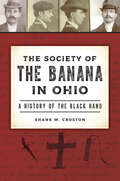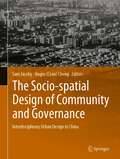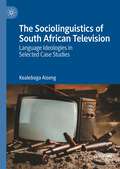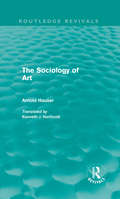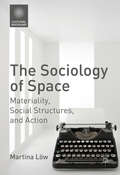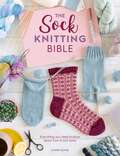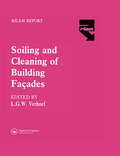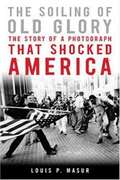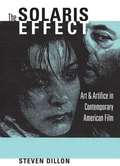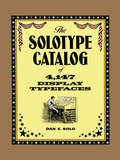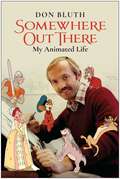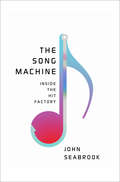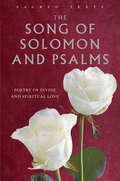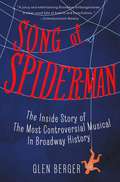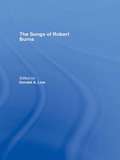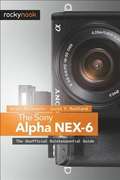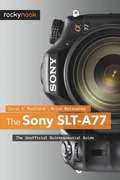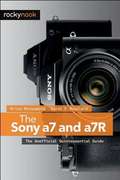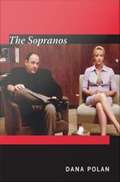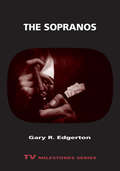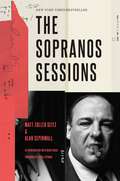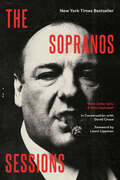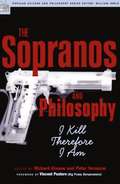- Table View
- List View
The Society of the Banana in Ohio: A History of the Black Hand (True Crime)
by Shane W. CrostonA notorious case of terror and extortion in the Buckeye StateIn the early 1900s, a criminal society known as the Black Hand became feared across the United States as it extorted hard-working immigrants. In 1908, Agostino Iannarino received a series of threatening letters and when he refused to pay, a bomb exploded at the entrance of his Columbus home. His family fled to Sicily only to continue receiving threats. The following year, U.S. Post Office Inspectors learned that a Black Hand gang called the Society of the Banana was headquartered in Marion, Ohio, and authorities attempted to put an end to the violent outrages occurring across the Midwest.Revealing twenty-four extortion letters written by members of the Society of the Banana, author Shane W. Croston details factual and fatal accounts of the Black Hand.
The Socio-spatial Design of Community and Governance: Interdisciplinary Urban Design in China
by Sam Jacoby Jingru Cyan ChengThis book proposes a new interdisciplinary understanding of urban design in China based on a study of the transformative effects of socio-spatial design and planning on communities and their governance. This is framed by an examination of the social projects, spaces, and realities that have shaped three contexts critical to the understanding of urban design problems in China: the histories of “collective forms” and “collective spaces”, such as that of the urban danwei (work-unit), which inform current community building and planning; socio-spatial changes in urban and rural development; and disparate practices of “spatialised governmentality”. These contexts and an attendant transformation from planning to design and from government to governance, define the current urban design challenges found in the dominant urban xiaoqu (small district) and shequ (community) development model. Examining the histories, transformations, and practices that have shaped socio-spatial epistemologies and experiences in China – including a specific sense of community and place that is rather based on a concrete “collective” than abstract “public” space and underpinned by socialised governance – this book brings together a diverse range of observations, thoughts, analyses, and projects by urban researchers and practitioners. Thereby discussing emerging interdisciplinary urban design practices in China, this book offers a valuable resource for all academics, practitioners, and stakeholders with an interest in socio-spatial design and development.
The Sociolinguistics of South African Television: Language Ideologies in Selected Case Studies
by Kealeboga AisengThis book explores the interwoven relationship between language, media, and society in post-Apartheid South Africa. The author examines selected case studies from the sociolinguistic landscape of South African television, analysing dominant language ideologies and illuminating the challenges, opportunities, and potential for transformation. He argues for the power of television in shaping language ideologies, fostering cultural understanding, and advocating for more inclusive and equitable language usage in the media. This book contributes to the field of sociolinguistics by emphasizing the complexity of multilingualism in South Africa and inviting ongoing exploration and dialogue in this landscape. It will be of interest to students and scholars of Sociolinguistics, Media Studies, African Culture and History, and Language Policy and Planning.
The Sociology of Art (Routledge Revivals)
by Arnold HauserFirst published in 1982, The Sociology of Art considers all forms of the arts, whether visual arts, literature, film, theatre or music from Bach to the Beatles. The last book to be completed by Arnold Hauser before his death in 1978, it is a total analysis of the spiritual forces of social expression, based upon comprehensive historical experience and documentation. Hauser explores art through the earliest times to the modern era, with fascinating analyses of the mass media and current manifestations of human creativity. An extension and completion of his earlier work, The Social History of Art, this volume represents a summing up of his thought and forms a fitting climax to his life’s work. Translated by Kenneth J. Northcote.
The Sociology of Space: Materiality, Social Structures, and Action (Cultural Sociology)
by Martina LöwIn this book, the author develops a relational concept of space that encompasses social structure, the material world of objects and bodies, and the symbolic dimension of the social world. Löw’s guiding principle is the assumption that space emerges in the interplay between objects, structures and actions. Based on a critical discussion of classic theories of space, Löw develops a new dynamic theory of space that accounts for the relational context in which space is constituted. This innovative view on the interdependency of material, social, and symbolic dimensions of space also permits a new perspective on architecture and urban development.
The Société des Trois in the Nineteenth Century: The Translocal Artistic Union of Whistler, Fantin-Latour, and Legros (Routledge Research in Art History)
by Melissa BerryThis book reframes the formative years of three significant artists: Henri Fantin-Latour, Alphonse Legros, and James McNeill Whistler. The trio’s coming together as the Société des trois occurred during the emergence of the artistic avant-garde—a movement toward individualism and self-expression. Though their oeuvres appear dissimilar, it is imperative that the three artists’ early work and letters be viewed in light of the Société, as it informed many of their decisions in both London and Paris. Each artist actively cultivated a translocal presence, creating artistic networks that transcended national borders. Thus, this book will serve as a comprehensive resource on the development, production, implications, and eventual end of the Société.
The Sock Knitting Bible: Everything you need to know about how to knit socks
by Lynne RoweThe definitive guide to knitting cozy, colorful socks, covering every aspect for knitters of all abilities.The Sock Knitting Bible is the ultimate reference for sock knitting skills, techniques, materials, projects, and more. Here you'll find in-depth information on everything from sizing and yarn to casting on and color-work. Whether you want to knit toe up, cuff down or even two at a time socks, this comprehensive volume covers it all.There are step-by-step instructions for all the various sock knitting techniques, as well as three basic sock patterns that even an absolute beginner can follow. Author Lynne Rowe also looks at the different kinds of tools available, from double pointed needles and small circular needles to innovative products such as flexible DPNs.And it all comes together with ten delightful projects by some of the most exciting and talented sock designers. Here you will find patterns for stripes, fair isle, cables, lacy, sparkly and snuggly socks: an array o pattern for all your sock-knitting needs!
The Soiling and Cleaning of Building Facades
by L.G.W. VerhoefThe report of a comprehensive investigation by RILEM which examines all aspects of the cleaning of facades, subject to soiling by both biological and non-biological agencies. The contributors are international authorities working in this field giving essential advice to all those who need to know how to approach the problems connected with the soiling and cleaning of building facades.
The Soiling of Old Glory: The Story of a Photograph That Shocked America
by Louis P. MasurSometimes a moment can change history. This one took 1/250th of a second. The photograph strikes us with visceral force, even years after the instant it captured. A white man, rage written on his face, lunges to spear a black man who is being held by another white. The assailant's weapon is the American flag. Boston, April 5, 1976: As the city simmered with racial tension over forced school busing, newsman Stanley Forman hurried to City Hall to photograph that day's protest, arriving just in time to snap the image that his editor would title "The Soiling of Old Glory. " The photo made headlines across the U. S. and won Forman his second Pulitzer Prize. It shocked Boston, and America: Racial strife had not only not ended with the 1960s, it was alive and well in the cradle of liberty. Louis P. Masur's evocative "biography of a photograph" unpacks this arresting image in a tour de force of historical writing. He examines the power of photography and the meaning of the flag, asking why this one picture had so much impact. Most poignantly, Masur recreates the moment and its aftermath, drawing on extensive interviews with Forman and the figures in the photo to reveal not just how the incident happened, but how it changed the lives of the men in it. The Soiling of Old Glory, like the photograph it is named for, offers a dramatic window onto the turbulence of the 1970s and race relations in America.
The Solaris Effect: Art and Artifice in Contemporary American Film
by Steven DillonWhat do contemporary American movies and directors have to say about the relationship between nature and art? How do science fiction films like Steven Spielberg's A.I. and Darren Aronofsky's π represent the apparent oppositions between nature and culture, wild and tame?<P><P> Steven Dillon's intriguing new volume surveys American cinema from 1990 to 2002 with substantial descriptions of sixty films, emphasizing small-budget independent American film. Directors studied include Steven Soderbergh, Darren Aronofsky, Todd Haynes, Harmony Korine, and Gus Van Sant, as well as more canonical figures like Martin Scorcese, Robert Altman, David Lynch, and Steven Spielberg. The book takes its title and inspiration from Andrei Tarkovsky's 1972 film Solaris, a science fiction ghost story that relentlessly explores the relationship between the powers of nature and art. The author argues that American film has the best chance of aesthetic success when it acknowledges that a film is actually a film. The best American movies tell an endless ghost story, as they perform the agonizing nearness and distance of the cinematic image.
The Solotype Catalog of 4,147 Display Typefaces
by Dan X. SoloThe author of many books on typography, Dan X. Solo was also the proprietor of his own typography shop in Oakland, California -- an establishment dedicated to unusual typography and special effects. This comprehensive catalog offers graphic designers a dazzling selection of over 4,000 typefaces and optical effects available from Solotype Typographers.Here, in Solo's words, is "a great cast of characters" -- the alphabet -- abetted by a cornucopia of typographical ideas and an endless resource of letters, words, phrases, slogans, logos, humorous comments, headlines, and graphic symbols. Individual sections of the book display a rich variety of typefaces in categories such as Condensed, Victorian, Art Nouveau, Art Deco, Rustic, Thick-and-tin, Calligraphic, Uncials, Latins, and Blackletter.Samples are imaginatively presented. "Stagecoach," for example, is printed in Fargo typeface, evoking dusty trails, rawhide, and ten-gallon hats, while "Sizzling summer savings" appears appropriately in the flamboyant Firebug typeface. All typefaces are indexed for quick and easy reference. As entertaining as it is practical and useful, this impressive treasury of versatile typefaces and optical effects will be indispensable to busy commercial artists as an inexhaustible source of typographic ideas and a "swipe file" of words, phrases, and letters for use in graphic art projects.
The Somewhere Out There: My Animated Life
by Don BluthAfter more than five decades in Hollywood, Don Bluth, the man behind some of the most iconic animated films ever made, tells his story. Don Bluth never felt like a Donald. So people have always called him Don. A matinee of Snow White and the Seven Dwarfs awakened something within him. Despite growing up in rural Texas and Utah, he practiced and worked hard to become an Hollywood animator. And after working alongside his idol Walt Disney, and on films including Sleeping Beauty, The Sword in the Stone, Robin Hood, Winne the Pooh, The Rescuers, and Pete&’s Dragon, he realized that the company had changed into something he didn&’t necessarily believe in. So made the industry-shocking decision to start his own animation studio. It was from that studio—Don&’s studio—that came such award-winning, generation-defining films as The Secret of NIMH, An American Tail, The Land Before Time, All Dogs Go to Heaven, Anastasia, and the video game Dragon&’s Lair. Now, after more than half a century in the movie business, Don is ready to tell the story of his life. How his passions for artistry, integrity, and his Mormon faith shaped him into the beloved icon whose creativity, entrepreneurship, and deeply-held beliefs entertained, enthralled, and inspired millions across the globe. Exclusive original art makes this book perfect for fans, cineasts, and anyone looking &“somewhere out there&” for inspiration and motivation.
The Song Machine: Inside The Hit Factory
by John Seabrook“An utterly satisfying examination of the business of popular music.” —Nathaniel Rich, The Atlantic Over the last two decades a new type of hit song has emerged, one that is almost inescapably catchy. Pop songs have always had a "hook," but today’s songs bristle with them: a hook every seven seconds is the rule. Painstakingly crafted to tweak the brain's delight in melody, rhythm, and repetition, these songs are highly processed products. Like snack-food engineers, modern songwriters have discovered the musical "bliss point." And just like junk food, the bliss point leaves you wanting more. In The Song Machine, longtime New Yorker staff writer John Seabrook tells the story of the massive cultural upheaval that produced these new, super-strength hits. Seabrook takes us into a strange and surprising world, full of unexpected and vivid characters, as he traces the growth of this new approach to hit-making from its obscure origins in early 1990s Sweden to its dominance of today's Billboard charts. Journeying from New York to Los Angeles, Stockholm to Korea, Seabrook visits specialized teams composing songs in digital labs with new "track-and-hook" techniques. The stories of artists like Katy Perry, Britney Spears, and Rihanna, as well as expert songsmiths like Max Martin, Stargate, Ester Dean, and Dr. Luke, The Song Machine shows what life is like in an industry that has been catastrophically disrupted—spurring innovation, competition, intense greed, and seductive new products. Going beyond music to discuss money, business, marketing, and technology, The Song Machine explores what the new hits may be doing to our brains and listening habits, especially as services like Spotify and Apple Music use streaming data to gather music into new genres invented by algorithms based on listener behavior. Fascinating, revelatory, and original, The Song Machine will change the way you listen to music.
The Song of Solomon and Psalms
by Gerald BenedictThis is a wonderful collection of some of the best-known and best-loved poetic texts from the Old Testament, as translated in the King James Bible.
The Song of Spider-Man
by Glen BergerFrom the show's cowriter who saw it all firsthand, this is the epic story of the most expensive, ambitious, dangerous, and controversial Broadway musical of all-time: Spider-Man.Never in the history of Broadway has there been anything like Spider-Man: Turn Off the Dark. Lampooned by reviewers, loved and loathed by audiences, and boldly envisioned by its producers, Spider-Man has forever made its mark in pop culture history. Author Glen Berger was present at the creation, when visionary director Julie Taymor selected him to collaborate with her on the book of the musical. For seven years, Berger was an eyewitness to great artistic hopes and battles as Taymor sought to bring her vision to the stage, along with celebrated rock stars Bono and the Edge. But despite terrible reviews and public ridicule, Spider-Man went on to become one of the top ten grossing musicals in the history of Broadway--a feat inseparable from its creators' unassailable passion, immense efforts, and artistic ambition. With a sharp eye for detail and candid sense of humor, Berger reveals every aspect--the highs and lows--of the production and in doing so, takes us inside the theatrical process in a way few authors can. The Song of Spider-Man is the ultimate fly-on-the-wall account of how Broadway works, how big musicals are made, and how great artists continue to dream, even in the midst of a nightmare.
The Songs of Robert Burns
by Donald A. LowIn this definitive work for our generation, Donald Low brings together, for the first time, the words and tunes of all Burns' known songs, both `polite' and bawdy. The Songs of Robert Burns were, in their author's eyes, the crown of his achievement as a poet. After years of study and investigation, many hours spent listening to old airs, as he recalled the living, daily, song-life of the people of Scotland, and through the creation of some of the finest lyric poetry produced in the British Isles, Burns' success is beyond doubt.
The Sony Alpha NEX-7
by Brian Matsumoto Carol F. RoullardThe Sony Alpha NEX-7: The Unofficial Quintessential Guide provides a wealth of experience-based information and insights for owners of this exciting new camera. Authors Carol F. Roullard and Brian Matsumoto team up to help the new user navigate past the confusion factor that often comes with complex and powerful camera equipment. This book explores the features and capabilities of the camera in a way that far surpasses the user's manual. It guides you through the camera features with step-by-step setting adjustments and detailed how, when, and why explanations for each option. Every button, dial, switch, and menu configuration setting is explored in a friendly manner, with suggestions and tips for setup according to various shooting styles. The informative text is illustrated with screenshots and example images throughout, making it easy to follow along. The authors cover everything from the basic features of the camera to numerous advanced photographic applications. The first section of the book teaches the new user to start taking pictures immediately by using the camera's Intelligent Automatic mode. The second section covers how to begin taking more control by switching to the semi-automatic modes. Finally, you'll learn to take full manual control of the camera, allowing you to break some "rules" and capture images that are a unique reflection of your creative personality. Carol and Brian go beyond just the camera itself and share how third-party software and optional accessories can improve on the camera's standard commands. You'll even learn how the electronic viewfinder, the fixed mirror, and Sony's novel shutter design improve the camera's utility for critical scientific photography (i.e., photomicrography and photography through the telescope).The Sony Alpha NEX-7: The Unofficial Quintessential Guide will allow you to really take control of your camera, to push the envelope, and to have fun.
The Sony SLT-A77
by Brian Matsumoto Carol F. RoullardThis book provides enthusiastic photographers with a wealth of information about the unique features of the Sony SLT-A77, an interchangeable-lens camera with an electronic viewfinder and a fixed, translucent mirror. The A77 differs from the current crop of DSLRs in its ability to use a phase detection focusing system throughout the entire picture-taking process, for both still photographs and videos. This provides an immediacy and responsiveness when using burst shots and creating HD videos that is unavailable in any other camera. In this guide, authors Carol Roullard and Brian Matsumoto teach you how to obtain exceptional photographs and videos as they cover everything from the basics of using the camera's automatic modes, to the more advanced aperture-priority, shutter-priority, program, and manual exposure modes. You'll also learn how best to take advantage of features such as the built-in dynamic range adjustment, sweep panoramic, GPS, colorization modes, facial detection and recognition, multiple shot exposures, and HD video. The authors provide you with an opportunity to improve your skills even further by discussing how third-party software and accessories can improve Sony's standard commands. You'll also learn about how the electronic viewfinder, fixed mirror, and Sony's novel shutter design improve the camera's utility for scientific photography through the microscope and telescope. Additional topics include:Advantages of the electronic viewfinder for previewing your photographs Using the accessory Sony shoe-mount flash Advantages of using the JPEG file format Advantage of having a fixed mirror and electronic first curtain shutter Settings for using the camera on a microscope and telescope Using the older Minolta Maxxum lenses
The Sony a7 and a7R
by Brian Matsumoto Carol F. RoullardThis book is a guide to using the Sony a7 and a7R, the first full frame, autofocus system cameras. At half the weight of a full frame DSLR, they are easy to carry for photographers on the go. The less-expensive a7 has a 24-megapixel sensor for shooting rapidly changing scenes; the a7R has a 36-megapixel sensor designed for ultimate image sharpness. Both use advanced image-processing algorithms and can use any manufacturer's lens when matched with the appropriate adapter. The electronic viewfinder gives the photographer an accurate preview of the image, ensuring the capture of technically excellent photographs by preventing mistakes in color temperature, depth of field, and exposure. All features of the a7 and a7R are covered, including automatic stitching to create panoramas, and multi-shot noise reduction that allows the use of extremely high ISOs. This book guides the photographer in using both the camera's automated features and manual controls to take photographs that are a unique reflection of his or her creative personality.
The Sopranos
by Dana Polan"In its original run on HBO, The Sopranos mattered, and it matters still," Dana Polan asserts early in this analysis of the hit show, in which he sets out to clarify the impact and importance of the series in both its cultural and media-industry contexts. A renowned film and TV scholar, Polan combines a close and extended reading of the show itself--and of select episodes and scenes--with broader attention to the social landscape with which it is in dialogue. For Polan, The Sopranos is a work of playful irony that complicates simplistic attempts to grasp its meanings and values. The show seductively beckons the viewer into an amoral universe, hinting at ways to make sense of its ethically complicated situations, only to challenge the viewer's complacent grasp of things. It deftly exploits the interplay between art culture and popular culture by mixing elements of art cinema--meandering plots, narrative breaks, and an uncertain progression--with the allure of a soap opera, delving into its characters' sex lives, mob rivalries, and parent-child conflicts. A show about corrupt figures who parasitically try to squeeze illicit profit from the system, The Sopranos itself seems a target of attempts to glom on to its fame as a successful TV series: attempts by media executives, marketers, critics and writers, and even presidential candidates. "Everyone wants a piece of Sopranos action," says Polan, and he traces the marketing of the series across both official and unauthorized media platforms, including cookbooks, games, DVDs, and the kitschy Sopranos bus tour. Critiquing previous books on The Sopranos, Polan suggests that in their quest to find deep meaning, many of the authors missed the show's ironic and comedic side.
The Sopranos
by Franco RicciOften hailed as one of the greatest television series of all time, The Sopranos is a product of its time, firmly embedded in the problems of post-industrial, post-ethnic America. In The Sopranos: Born under a Bad Sign, Franco Ricci examines the groundbreaking HBO series and its impact as a cultural phenomenon.Ricci demonstrates an encyclopedic knowledge of the series, the genre, and their social context in his analysis of the show's complex themes and characters. He explores The Sopranos' deep engagement with problems of race, class, gender, and identity, specifically in its portrayal of the Italian-American experience, consumer and media-driven society, and contemporary psychosocial issues. The series' protagonist, Mafia boss and patriarch Tony Soprano, in many ways embodies the anxieties of our age. Focusing on Tony's internal struggles and interactions with his therapist, family, and associates, Ricci traces this archetypal character's existential conflicts and sheds light on his search for self, connection, and meaning.Comprehensive in scope and sophisticated in approach, The Sopranos: Born under a Bad Sign is richly rewarding reading for anyone with an interest in the popular television drama, both as entertainment and social commentary.
The Sopranos (TV Milestones)
by Gary EdgertonFrom its premiere in 1999, The Sopranos captivated viewers with its easily relatable protagonist who has troubles at work and home, and went on to be one of the most critically successful shows in television history. By demonstrating that TV could be at once artistic and profitable, complex and engaging, edifying and entertaining, the series also redefined the prime-time drama. In this volume, author Gary R. Edgerton delves into the entire run of The Sopranos, integrating the existing scholarly literature, while also going much further than any previous source in exploring the series' innovations and legacy. First, Edgerton describes and analyzes The Sopranos' enormous business and industrial significance within the context of HBO as a network, a diversified entertainment company, and an identity brand. In chapter 2, he examines the many autobiographical influences and work experiences of creator David Chase and the narrative antecedents that informed the series' beginnings. In chapter 3, Edgerton underscores The Sopranos' deeply evocative sense of place, honing in especially on the cultural geography of New Jersey as representative of the nation as a whole. Finally, in chapter 4, Edgerton highlights how The Sopranos marks "A Midlife Crisis for the Gangster Genre" by illustrating some of the most profound generic transformations that took place over the course of the show, while his conclusion summarizes The Sopranos' ongoing industrial, aesthetic, and cultural legacy. The Sopranos is widely recognized in both popular and scholarly literature as a turning point in the history and development of TV. Fans who want to learn more about the show and scholars of television history will enjoy this entertaining and educational volume.
The Sopranos Sessions
by Alan Sepinwall Matt Zoller SeitzThe Sopranos Sessions, a collection of recaps, conversations, and critical essays covering every episode. Featuring a series of new long-form interviews with series creator David Chase, as well as selections from the authors' archival writing on the series, The Sopranos Sessions explores the show's artistry, themes, and legacy, examining its portrayal of Italian Americans, its graphic depictions of violence, and its deep connections to other cinematic and television classics.
The Sopranos Sessions: A Conversation with David Chase
by Alan Sepinwall Matt Zoller SeitzNew York Times–Bestseller: “The authors’ interviews with Chase are endlessly illuminating . . . the definitive celebration of a show that made history.” —Kirkus ReviewsOn January 10, 1999, a mobster walked into a psychiatrist’s office and changed TV history. By shattering preconceptions about the kinds of stories the medium should tell, The Sopranos launched our current age of prestige television, paving the way for such giants as Mad Men, The Wire, Breaking Bad, and Game of Thrones. As TV critics for Tony Soprano’s hometown paper, New Jersey’s The Star-Ledger, Alan Sepinwall and Matt Zoller Seitz were among the first to write about the series before it became a cultural phenomenon. Now they have reunited to produce The Sopranos Sessions, a collection of recaps, conversations, and critical essays covering every episode. Featuring a series of new long-form interviews with series creator David Chase, as well as selections from the authors’ archival writing on the series, The Sopranos Sessions explores the show’s artistry, themes, and legacy, examining its portrayal of Italian Americans, its graphic depictions of violence, and its deep connections to other cinematic and television classics. “Includes highly detailed recaps of each episode [and] a debate about the much-discussed final moment of the final episode.” —The New York Times“Excellent . . . an enjoyable read.” —The Irish Times
The Sopranos and Philosophy: I Kill Therefore I Am
by Peter Vernezze Richard GreeneThis book explores everything from Aristotle to ziti. The chapters cover topics from each of the traditional branches of western philosophy: metaphysics (the problem of evil, philosophical psychology), epistemology (self-knowledge), value theory (ethics, aesthetics, political philosophy), as well as eastern philosophy (Sun Tzu), history of philosophy (Plato, Nietsche, Machiavelli) and contemporary postmodern themes (feminism and identity issues).
